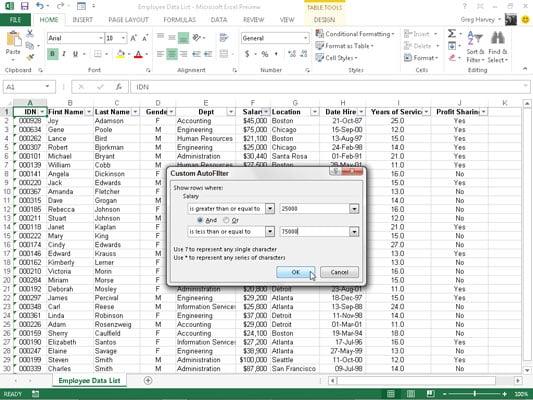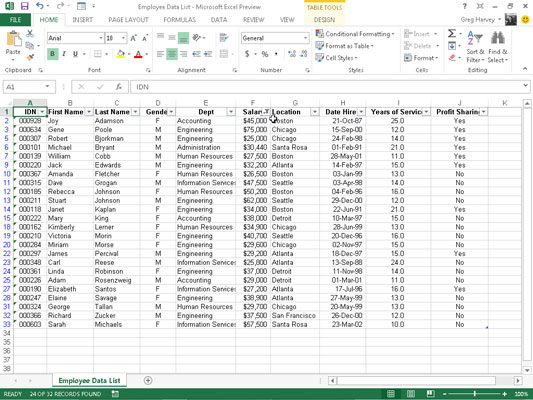The Filter "Begins With..." Option Is Found On Which Type Of Filter?
In addition to filtering a data list to records that contain a item field entry in Excel 2013, you tin create custom AutoFilters that enable you to filter the list to records that meet less-exacting criteria (such as concluding names starting with the letter One thousand) or ranges of values (such equally salaries between $25,000 and $75,000 a year).
To create a custom filter for a field, you click the field'southward AutoFilter push button and then highlight Text Filters, Number Filters, or Engagement Filters (depending on the type of field) on the drop-downward list and then click the Custom Filter option at the bottom of the continuation list. When you select the Custom Filter option, Excel displays a Custom AutoFilter dialog box.
You can as well open the Custom AutoFilter dialog box past clicking the initial operator (Equals, Does Not Equal, Greater Than, and and then on) on the field's Text Filters, Number Filters, or Engagement Filters submenus.

In this dialog box, you select the operator that you desire to use in the first drib-down list box. Then enter the value (text or numbers) that should exist met, exceeded, fallen beneath, or non found in the records of the database in the text box to the right.
| Operator | Instance | What It Locates in the Database |
|---|---|---|
| Equals | Bacon equals 35000 | Records where the value in the Salary field is equal to $35,000 |
| Does non equal | State does not equal NY | Records where the entry in the State field is not NY (New York) |
| Is greater than | Zilch is greater than 42500 | Records where the number in the Zip field comes afterward 42500 |
| Is greater than or equal to | Aught is greater than or equal to 42500 | Records where the number in the Naught field is equal to 42500 or comes after it |
| Is less than | Salary is less than 25000 | Records where the value in the Bacon field is less than $25,000 a year |
| Is less than or equal to | Salary is less than or equal to 25000 | Records where the value in the Bacon field is equal to $25,000 or less than $25,000 |
| Begins with | Begins with d | Records with specified fields have entries that start with the letter of the alphabet d |
| Does not begin with | Does non begin with d | Records with specified fields have entries that do non offset with the alphabetic character d |
| Ends with | Ends with ey | Records whose specified fields take entries that terminate with the messages ey |
| Does not stop with | Does not end with ey | Records with specified fields have entries that do not end with the messages ey |
| Contains | Contains Harvey | Records with specified fields have entries that comprise the name Harvey |
| Does not incorporate | Does not comprise Harvey | Records with specified fields have entries that don't contain the proper noun Harvey |
If you want to filter records in which only a particular field entry matches, exceeds, falls beneath, or just is non the same as the one you enter in the text box, you lot then click OK or printing Enter to apply this filter to the database. You can use the Custom AutoFilter dialog box to filter the database to records with field entries that fall within a range of values.
To set a range of values, you select the "is greater than" or "is greater than or equal to" operator for the top operator and then enter or select the lowest (or commencement) value in the range. And then, make sure that the And option is selected, select "is less than" or "is less than or equal to" as the bottom operator, and enter the highest value in the range.
You lot can run into how to filter the records in the Employee Data List so that just those records where Salary amounts are betwixt $25,000 and $75,000 are displayed. You set up up this range of values equally the filter by selecting "is greater than or equal to" as the operator and 25,000 every bit the lower value of the range.
And then, with the And option selected, you lot select "is less than or equal to" as the operator and 75,000 as the upper value of the range. Yous tin run into the results of applying this filter to the Employee Data List.

To ready up an either/or condition in the Custom AutoFilter dialog box, you unremarkably choose betwixt the "equals" and "does not equal" operators and and then enter or select the showtime value that must exist met or must not be equaled. Then you select the Or pick and select whichever operator is appropriate and enter or select the 2nd value that must be met or must not be equaled.
For example, if you want to filter the data list so that only records for the Accounting or Human being Resource departments in the Employee Data Listing appear, y'all select "equals" every bit the starting time operator then select or enter Accounting every bit the commencement entry.
Next, you click the Or option, select "equals" equally the 2d operator, and and so select or enter Human Resources equally the second entry. When you lot then filter the database by clicking OK or pressing Enter, Excel displays only those records with either Accounting or Homo Resources as the entry in the Dept field.
The Filter "Begins With..." Option Is Found On Which Type Of Filter?,
Source: https://www.dummies.com/article/technology/software/microsoft-products/excel/how-to-use-custom-filters-in-excel-2013-170947
Posted by: myersborceir.blogspot.com


0 Response to "The Filter "Begins With..." Option Is Found On Which Type Of Filter?"
Post a Comment